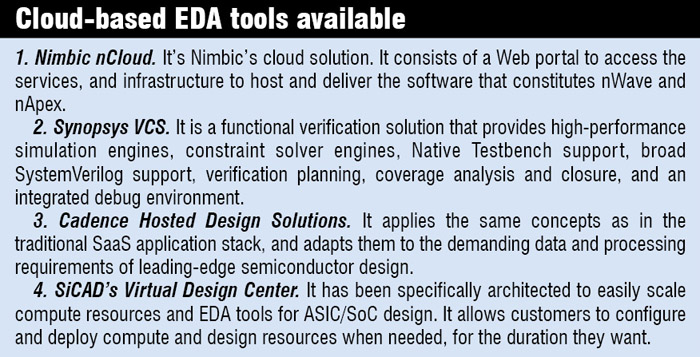We are all aware of the paradigm shift in the computing world with the move to the cloud. What started as a dumb (no computation ability) online data storage solution in the 1950s, has now evolved into applications that run entirely from within the cloud, Microsoft’s Office 365 being one such example. Well, if wordprocessors made it to the cloud, it was only a matter of time before we saw much more sophisticated suites following the path.
We now have several EDA solutions available in the cloud in the form of ‘software as a service’ (SaaS) offerings, which, in turn, has made a subtle shift in the EDA landscape. We shall discuss below how this helps electronics design houses, and why some feel that it is high time for a radical change.
Enormous benefits
We all know of the Moore’s law, and how transistor count (and chip complexity) doubles roughly every two years. Well, if the chips are getting twice as complex, the work that goes into designing them is going to be just as tough while schedules are shrinking. In such a scenario wouldn’t it be better to be able to harness the power of thousands of servers through the Internet rather than using local compute centres?

Kickstart your project and reduce turnaround time. Hosted design solutions provide a design environment that is ready to go—customers can plug into it remotely and begin designing on their first day itself.
“Smaller design firms tend to more easily value a SaaS-style model’s benefits because their resources may be limited and this program allows them to immediately get a flow up and running,” explains Larry Drenan, group director for services, Cadence Design Systems, Inc.
A cloud-based EDA solution would give you the ability to exploit parallelism in your tools and utilise the virtually umpteen number of computers to run multiple parallel jobs simultaneously.
“In ideal form, EDA in the cloud would provide elasticity to design teams where resource sharing could be easier, meeting timelines would be easy and load sharing could be simpler. In many cases, this could also help small business owners to use EDA tools at lower total costs than investing huge amounts into single-/multi-user licensing fees,” explains T. Anand, managing director, Knewron. Ultimately, this means that you have the chance to make an early entry to the market.
Faster access to updates and enhanced flexibility. Since the software itself is on the Internet, any new improvements and updates that are being provided by your vendor will now be quickly installed and easily available to you. Imagine updating your EDA tool just as you would update your WordPress installation—with the click of a button.
Since EDA in the cloud is a SaaS offering, you will have the flexibility to control the resources you need and to remove what you don’t. On the other hand, if you are working on an urgent project and need extra services to help meet your deadline, you can activate those too.
Larry explains, “Our service packages can be tailored to expand and shrink as a client’s project or projects evolve, without a large up-front capital investment.”
All is not well
What could go wrong here? Good question!
Transferring the data. One of the drawbacks of using any cloud-based tool is the huge amount of Internet data transfer as a result. This situation will worsen if the user insists on keeping data stored on the local server as opposed to leaving it on the cloud.
Dr Raul Camposano, CEO, Nimbic, explains in his whitepaper Electronic Design in the Cloud, “A common connection of 10 Mbps allows up to 75 MB of data transfer in one minute (theoretical maximum). The user has to decide if it is practical to transfer design data back and forth to the cloud for a given application. In the case of nWave for example, the design data and results are only a few megabytes, allowing for a transfer of data to/from the cloud in seconds. Compared to the compute time required to solve a problem, often in the hours or days, this is negligible. For other applications that require more data, an alternative is to leave the data in the cloud, using a service such as Amazon’s S3.”

However, not everyone is open to the idea of leaving data on the cloud, especially when considering data security.
Data security. Data security is a sensitive topic. With the proliferation of cloud-based solutions in a lot of cloud-based applications, there have been numerous cases of personal data being misused for other purposes. Could a variation of the same problems crop up while designing on the Internet?
“Major issue I foresee is design sanctity and security. When the design data has to be on the cloud, as a design house, I would want my data to be absolutely secure and untouchable as it is a core part of the business. And since cloud model for other services has still not proven its capability in all aspects, its viability for EDA is under question,” says Anand.






